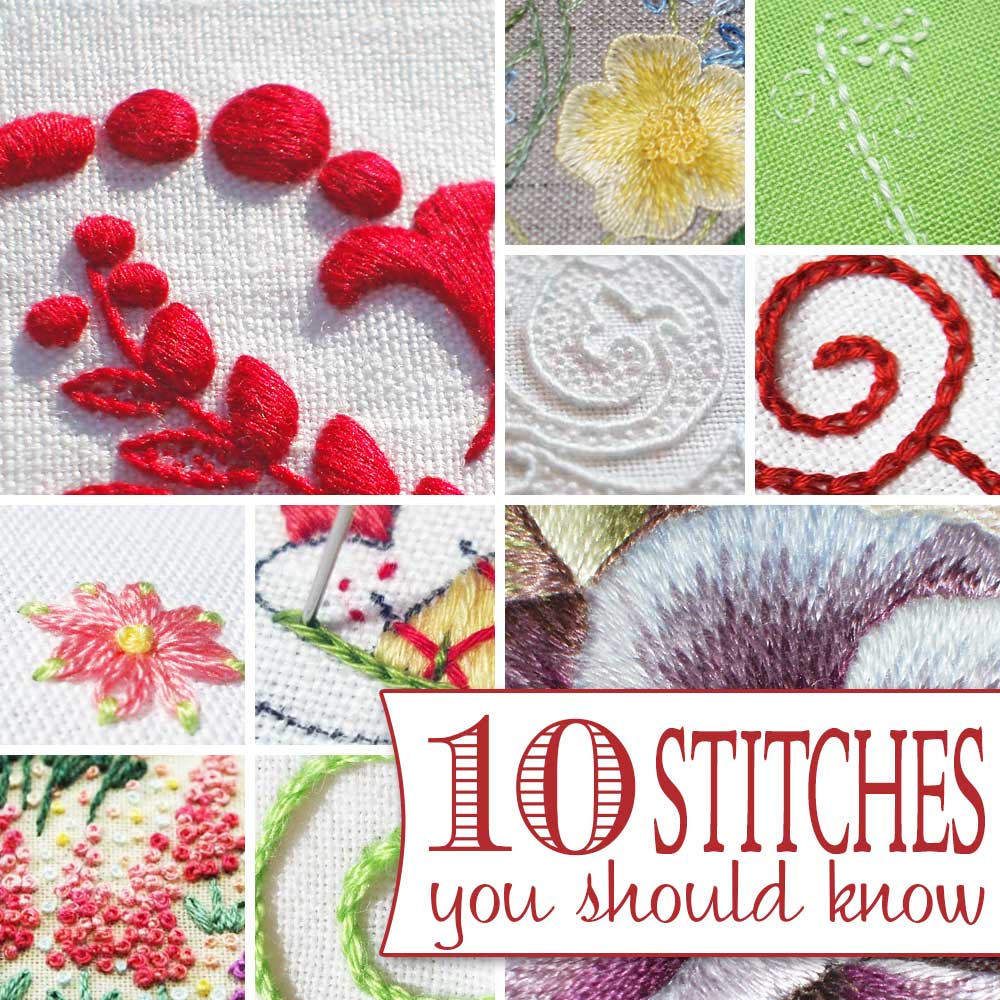Today, I’m going to go out on a limb and offer a list of the 10 hand embroidery stitches that I think every beginner (and beyond) should learn.
I get the question often: I’m just getting into hand embroidery. What stitches should I learn first?
There are hundreds and hundreds of embroidery stitches out there, so answering that question can be somewhat difficult.
After giving it some thought, I’ve narrowed my recommendations down to 10 stitches that every embroiderer should know and that the beginner can aim to learn, that will provide the stitcher with a good foundation for future growth and plenty of entertainment and versatility.

Here’s my list of 10 stitches you should know. Examine it, and let me know what you think! What would you add to it and eliminate from it, if you had to come up with ten (and only ten) stitches for a similar list?
10 Hand Embroidery Stitches to Know
1. Running Stitch – This is a very basic stitch. The beginner, regardless of age, can conquer it. Running stitch is the foundation of other stitching techniques and a good place to start.
2. Back Stitch – Another stitch that beginners at any age can learn easily, backstitch is also the foundation of many other embroidery stitches and an integral part of many embroidery techniques.
3. Split Stitch – Slightly more difficult that the previous stitches, split stitch can be used in myriad ways in embroidery, from shaded fillings to fine lines to padding under other stitches.
4. Stem Stitch – You shouldn’t be surprised that I’m including this one! It’s my favorite stitch, for both its beauty and its versatility. It creates neat lines, fine or heavy, and it can be used very effectively for fillings.
5. Chain Stitch – Another foundation stitch for many other stitches, the chain stitch can be used for lines and fillings, and it is an integral part of many embroidery techniques.
6. Detached Chain Stitch – It’s the ideal stitch for simple petals and leaves!
7. French Knot – It’s the ideal stitch for small, textured knots and dots. (The Colonial Knot makes a good substitution.)
8. Buttonhole Stitch – Another foundation stitch, the buttonhole stitch is employed in many different embroidery techniques. It’s useful for fillings, for decorative lines, for edging, and in many other applications.
9. Satin Stitch – The queen of solid filling stitches, satin stitch should be in every embroiderer’s repertoire.
10. Long & Short Stitch – While long & short stitch may seem like an advanced stitching technique, it really is a very forgiving stitch and quite easy in its basic form. It can be used to fill large and small spaces with solid color or with shades of color. It is most effectively used for needle painting. It’s one of those stitches that the beginner will never regret conquering.
I think those ten stitches would give any embroiderer a good foundation and even a good stand-alone repertoire that would provide years and years of pleasurable stitching.
Any additions and subtractions? What stitches do you think should be on such a list and why? Just remember, the magic number is 10, so if you add a stitch to the list, you have to take one off! I’m all ears – join the conversation below!
